BISAC NAT010000 Ecology
BISAC NAT045050 Ecosystems & Habitats / Coastal Regions & Shorelines
BISAC NAT025000 Ecosystems & Habitats / Oceans & Seas
BISAC NAT045030 Ecosystems & Habitats / Polar Regions
BISAC SCI081000 Earth Sciences / Hydrology
BISAC SCI092000 Global Warming & Climate Change
BISAC SCI020000 Life Sciences / Ecology
BISAC SCI039000 Life Sciences / Marine Biology
BISAC SOC053000 Regional Studies
BISAC TEC060000 Marine & Naval
Lagoons are one of the most vulnerable ecosystems to impacts of natural environmental and anthropogenic factors. The Curonian and Vistula Lagoons are one of the largest lagoons of Europe. The Curonian Lagoon is choke mostly freshwater, while the Vistula Lagoon is restricted brackish water. Hydrological, chemical and biological researches were carried out monthly since 1991 to 2014. Reductions of nutrients loading in 1990s did not result in improvement of the ecological situation. Hydrological and chemical parameters are the main factors that influence on the algal blooms and ecosystem health in these lagoons. The Curonian Lagoon may be characterized as hypertrophic water body with "poor" water quality. Climate change in 1990s-2010s combined with other factors (freshwater, slow-flow exchange, high nutrients concentrations) creates conditions for Cyanobacteria “hyperblooms”. Harmful algal blooms result in deterioration of the water chemical parameters and death of fish. "Hyperblooms" is the most dangerous for coastal towns and tourist resorts (UNESCO National Park "Curonian Spit"). Climate change in 1990s-2000s have been also observed in Vistula Lagoons (mean annual temperature increased by 1.4°С for 40 years), but brackish water prevent harmful algal hyperblooms. After the invasion of the filter-feeding mollusk Rangia water quality was significantly improved in 2011-2014, but ecosystem productivity remained at a stable long-term level.
climate change, Curonian and Vistula Lagoons, primary production, phytoplankton, eutrophication.
I. Introduction
Till 40th of XX century Baltic Sea was oligotrophic with relatively low biological productivity. During the XX century there has been intense human impact, especially in the coastal zone. In XX century the eutrophication of waters increased due to increase nutrients loading, and simultaneously climatic changes were observed in the Baltic Sea and its coastal bays and lagoons. The annual warming trend for the Baltic Sea basin has been shown to be 0.08°C/decade. This is somewhat larger than the trend for the entire globe (1861–2000), which is about 0.05°C/decade. The increase in water temperature can affect nutrient recycling and influence on phytoplankton species composition and primary production. For example, water warming may stimulate summer bloom warm-water Cyanobacteria [1, 2].
The Curonian Lagoon and Vistula Lagoon are the largest coastal lagoons of the Baltic Sea separated from the sea by narrow sand spits. These Lagoons are similar in ground types, mean depths, wind and temperature regimes, however quite different in continental runoff and water salinity. The Curonian and Vistula Lagoons are playing an important part in many fields of economy of Russia (Kaliningrad region), Lithuania and Poland. The watershed areas are located in density populated district with highly developed industry and agriculture. During recent decades, significant anthropogenic changes occurred in the Lagoons and their watershed areas. The Curonian Lagoon receives water from the River Nemunas, the third-largest contributor (after the Vistula and Oder) of total nitrogen and phosphorus to the Baltic Sea. The Vistula Lagoon receives water from the River Pregolya. Until the late 1980s nutrients loading exceeded by many times the permissible nutrients loading leading to eutrophication of water body with such mean depths. Multiple reductions of nutrients loading from the watershed area in 1990s owing to the economic crisis in the industry and agriculture did not result in considerable improvement of the ecological situation. Ongoing eutrophication and harmful algal blooms are the most important problems in the lagoons. Harmful algal blooms result in deterioration of the water chemical parameters, accumulation of algal toxins, oxygen deficiency and death of fish in the coastal zone.
Coastal lagoons are most vulnerable to direct impacts of natural environmental and anthropogenic factors including the processes observable at climate change and anthropogenic eutrophication. Due to this sensitivity, the analysis of long-term changes of hydrological, chemical and biological parameters in lagoons could help to demonstrate the actual relationship between global and local changes, discrimination what is “natural” from what is due to the human action. The purpose of this article is to analyze temporal changes of phytoplankton production, chlorophyll and nutrients concentrations in the water and to evaluate the impact of abiotic factors on eutrophication and primary production of the Curonian and Vistula Lagoons.
II. Materials and methods
The researches was carried out at 12 stations in the Russian parts of the Curonian Lagoon and 9 stations in the Russian parts of the Vistula Lagoon monthly from March (April) to November (October) since 1991 to 2014 (Fig. 1). Monitoring includes a lot of biological (chlorophyll, primary production, phytoplankton), chemical (nutrients, BOD5, etc.), physical (transparency, temperature, salinity) parameters.
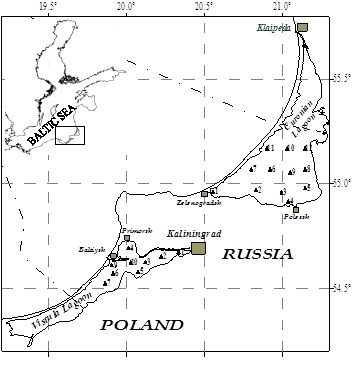
Fig. 1. Sampling sites in the Russian part of the Curonian Lagoon and Vistula Lagoon
The hydrological and hydrochemical parameters (water temperature, transparency and salinity, concentration of nutrients, including phosphate, nitrate, ammonia nitrogen, total phosphorus and nitrogen) were assessed in water samples from the surface layer with standard methods [3]. Concentration of chlorophyll a (Chl) was estimated at the surface, at the lower boundary of the photic zone and near the bottom. The concentration Chl a was determined by spectrophotometric method. Water samples were filtered through 0.3 μm membrane filters. The filters containing the phytoplankton were extracted using a 90% acetone solution and the optical density was measured at 5 wavelengths, i.e., 750, 664, 647, and 630 nm [4]. The photosynthesis intensity was measured applying the oxygen modification of the bottle method with short-period (3-5 hours) exposition of samples. In calculations of the primary production per unit area (m2) the rates of photosynthesis and mineralization of organic matter were measured at 4 depth levels of the photic zone (100, 46, 10, 1 % of subsurface light intensity), and in the near-bottom layer. The sampling depths of subsurface light intensity are determined with underwater photometer or with use of dependence between subsurface light intensity and transparency of water on Secchi disk. The lower boundary of the photic zone was assumed at the depths of 1% of subsurface light intensity [5].
Long-term data on the water temperature were estimated on the basis of daily observations at standard hydrometeorological stations in the Curonian Lagoon (v. Otkrytoye) and Vistula Lagoon (v. Krasnoflotskoye), which were submitted by the Kaliningrad Center for Hydrometeorology.
The assessment of water eutrophication of the Curonian Lagoons was carried out according to trophic classification [6, 7]. According to these classifications (on the basis of Chl a, nutrients and primary production) 4 types of trophic state are allocated: oligotrophic, mesotrophic, eutrophic and hypertrophic.
3. Results and Discussion
Trophic status and effect of the climate change in the Curonian Lagoon
The Curonian Lagoon may be characterized as a hypertrophic water body on the basis of long-term chemical and biological data according to trophic classification [6, 7]. Hypertrophic status is observed on all water area of the Curonian Lagoon. In July-October intensive development of Cyanobacteria leading to the water “blooming” was observed in the Curonian Lagoon [8, 9]. The initial reason of hypertrophic state the Curonian Lagoon and blooms of Cyanobacteria was intensive external nutrients loading in XX century as the watershed area is located in density populated district with highly developed industry and agriculture. During 1989-1990, in the period of maximum fertilizers usage in agriculture and industrial development, the annual input of phosphorus were 3.7-8.5 g/m2 and that of nitrogen – 60.8-109.6 g/m2. Reduction of industrial production and fertilizers usage in 1990s resulted in a decrease of the external nutrients loading by 3-4 times to 0.75-2.3 g/m2 of phosphorus and to 20.8-40.4 g/m2 of nitrogen per year [10]. However, the research showed that neither a decrease of the trophic status nor an improvement of the ecological situation occurred in the Curonian Lagoon in 1990s-2010s. In the Russian part of the lagoon in 2001-2014 increased the number of stations where the average for the growing season Chl a concentration greater than 100 mg/m3, and at these stations there is an extremely high level of eutrophication of waters. The concentration of Chl a and primary production in this lagoon are one of greatest in water bodies of basin of the Baltic Sea. The eutrophication processes and water “blooming” were most pronounced in the southern and central parts (the Russian zone) of the Curonian Lagoon (75% of the area), where the environmental conditions (high concentrations of nutrients in silt, continuously resuspension into the water column due to shallow depths, absence of the sea water intrusion, slow water exchange, fresh water) were favored for Cyanobacterial development. In northern, Lithuanian part the Curonian Lagoon the level of eutrophication and phytoplankton production are usually lower. This area adjoins to sea strait and is under influence of river flow Neman and Baltic Sea. Hydrodynamic activity (high flowing velocity) and brackish water prevent the “hyperblooming” of Cyanobacteria.
Eutrophication of the Curonian Lagoon affects at all trophic levels and primarily the intensity of phytoplankton development. The species typically abundant in eutrophicated waters prevailed in the phytoplankton (Aphanizomenon flos-aquae, Мicrocystis aeruginosa, Aulacosira islandica, Actinocyclus normanii, Stephanodiscus hantzchii, S. minutulis, etc) [9]. In summer, the ratio of mineral forms nitrogen and phosphorus (N:P <7) and phosphate concentration (30-40 mgP/m3) create conditions for regular hyperblooms of Cyanobacteria (concentration Chl a > 100 mg/m3). The annual cycle of primary production is characterized by summer maximum, which corresponds to maximal temperature of water and beginning bloom of Cyanobacteria (Fig. 2). During hyperblooms in the Curonian Lagoon Chl a reaches to 208-904 mg/m3 and primary production - 9-16 g C /(m3 day). This phenomenon is typical of eutrophic water bodies. A similar model of seasonal dynamics was already recorded in 1974-1976. A specific feature of 2000s was a high rate of primary production within a considerable part of growing period. In particular, in 2002 values of primary production, chlorophyll concentration and phytoplankton biomass close to maximum were recorded for three months (from July to September), which can be attributed to the hydrometeorological features of this year, e.g., high temperature (20°C and more) persisted until mid-September. Only after cooling and a temperature drop down to 7-8°C, which was recorded in November or October, blooming of Cyanobacteria in the Curonian Lagoon ceased and organic matter production by phytoplankton abruptly decreased.
On the average for the period 2001-2014 phytoplankton primary production exceeded mineralization of organic matter on 30%. Such ratio testifies to accumulation of organic matter in water and sediments and further eutrophication of the Curonian Lagoon where on greater part of area slow water exchange is observed (Fig. 2a).
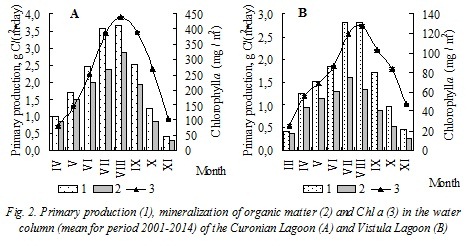
The Curonian Lagoon is characterized with high variability of Chl a, primary production and others trophic status indices in different years. The mean concentration of Chl а for the growing season (April - October) in varied between 36.2 and 210.0 (mean 99.7) mg/m3. The primary production varies between 360 and 668 (mean 553) gC/(m2∙year) (Fig. 3).
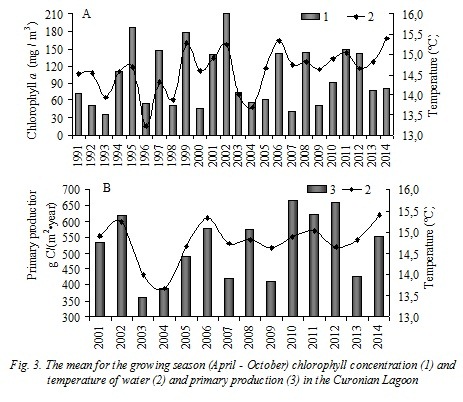
The years of maximum values of Chl а and primary production coincide with the years of maximum water warming-up and the hyperbloom of Cyanobacteria. For the period 1991–2014 Pearson correlations between average for the growing season (April–October) water temperature (t) and Chl a was 0.65. Of the hydrological and hydrochemical conditions existing in the most parts of the Lagoon, water temperature is the key factor determining the seasonal and long-tern variability of the primary production and abundance of phytoplankton. Тhe optimal temperature for reproduction “outburst” and nitrogen fixing for Aphanizomenon flos-aquae which produces water hyperblooming is above 20С [11, 12]. “Hyperblooming” of Cyanobacteria was observed at the mean water temperature above 20°С for summer and above 14.5 °С for the growing season (April-October) in the Curonian Lagoon. Small fluctuations of the mean summer water warming-up (in 2-3ºС) resulted in 2-4-fold variations of the trophic status indices (Fig. 3).
In XX and XXI centuries in the Baltic Sea and its watershed area warming trend were observed due to climatic changes. The trend to increase the mean water warming-up was recorded in the Curonian Lagoon (from 14.10°С in 1970s to 14.96°С in 2010s, i.е. equaled to 0.86°С for the latest 45 years). During the latest decades the trend towards increase number of “warm” years has been observed. The mean for the growing season water temperature above 14.5°С, typical to “hyperblooming”, was observed 3 times in 1970s, 4 times in 1980s, 6 times in 1990s, and 13 times in 2000s (Fig. 4). In these “warm” years Cyanobacteria formed high biomass in summer and autumn owing to “outburst” reproduction pattern in combination with consumption of ammonia nitrogen and nitrogen fixation and high concentration of phosphorus in the water, which results in hyperblooms in the Curonian Lagoon.
The research of phytoplankton in 1980s-2010s showed that biomass of Cyanobacteria and Chl a in summer was always at the level of intensive bloom (10-100 g/m3 in summer or 100 mg Chl a/m3 average for the growing season) and during 13 seasons it reached the hyperbloom state (above 100 g/m3 and 100 mg Chl a/m3). “Hyperblooming” of Cyanobacteria was observed during 3 years in 1980s in the period of the most intensive nutrients loading and the remaining 10 years “hyperblooming” of Cyanobacteria were observed in 1990s-2010s when the input of nutrients from lagoon’s watershed area multiple decreased [8, 9, 13].
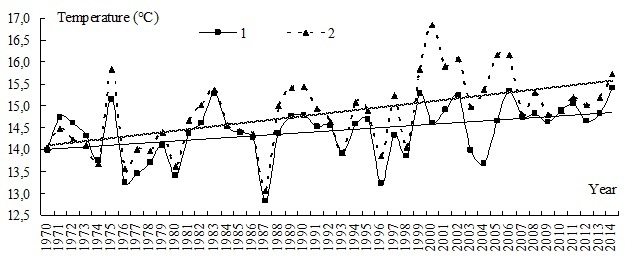
Fig. 4. The mean for the growing season (April – October) temperature of water in the Curonian Lagoon (1) and Vistula Lagoon (2)
The trend to increase the primary production of phytoplankton was recorded in the Curonian Lagoon in 2000s and 2010s (Fig. 5). Mean annual primary production in 2000s and 2010s (490 and 570 gC/(m2∙year)) is 2 times higher, than in the middle of 1970s (300 gC/(m2∙year)). That can testify about significant eutrophication in this lagoon for last thirty years where hyperbloom of Cyanobacteria are observed.
Fig. 5. Long-term trend of the primary production of phytoplankton in the Vistula Lagoon (1) and Curonian Lagoon (2)
In the years of hyperbloom of the Curonian Lagoon, Cyanobacteria biomass during the months July-October exceeded the level at which the eutrophication and pollution of the water body is observed. During the hyperbloom the biomass of Cyanobacteria may attain 1200-2500 mg/l, and concentration of Chl a - 700-3400 μg/l. Concentration and decomposition of Cyanobacteria leads to the oxygen deficit till to absolute absence (16% – 0% saturation) and death fish in the coastal zone [9]. These phenomena are of local nature and determined by direction of the wind during the bloom period. The years with persistent east winds in July-August resulted in the wind-driven aggregation of Cyanobacteria near the western coast, which is the most inhabited and recreationally developed area (the resort city Zelenogradsk and the National Park of Curonian Spit) are most unfavorable.
Cyanobacteria blooming have become a serious problem in recent decades, because many bloom-forming species are reported to be able to produce secondary metabolites toxic to many organisms, including fish, mammals and humans. The toxic Cyanobacteria species found in the Curonian Lagoon and can produce microcystins, neosaxytoxins, anatoxin. During the period of Cyanobacteria blooming concentration microcystins varied between 0.1 and 134 μg/l in water of the Curonian Lagoon Curonian Lagoon whereas safe level of 1.0 μg/l for drinking water Algae toxins also detected in sediments, mussels and fish. Fishes are most vulnerable to Cyanobacteria effect [13, 14]. Fish intoxication by toxins of Cyanobacteria results in pathological damages. In the period of Cyanobacteria hyperblooming in the Curonian Lagoon the morphopathological and histopathological changes were found in 70-80% of mature bream (Abramis brama). The detected pathological changes in fish were similar to the symptoms of affected by toxins of Cyanobacteria which dominated in summer and autumn [15]. This indicates the possible toxic impact of Cyanobacteria on fish and pollution effect on the ecosystem.
So, the more intensive water warming and the increase in the number of “warm” years in 1990s-2010s created favorable conditions for hyperblooming Cyanobacteria and increase of primary production. The local climate warming in the Baltic region is a probable reason of the ongoing eutrophication and harmful algal blooms of the Curonian Lagoon despite of significant reduction of external nutrients loading in 1990-2000s. Climate changes represents a risk for coastal water bodies, as this stimulates hyperblooms of Cyanobacteria.
Trophic status and effect of the climate change in the Vistula Lagoon
Vistula Lagoon is located in the densely populated area with developed industry and agriculture. Lagoon is subject to the strong impact of the anthropogenic factors (nutrients and pollutants input with river flow and waste water). Vistula Lagoon receives the intensity of external nutrient load to the river runoff and waste water from cities (especially from Kaliningrad). Еutrophication is most strongly expressed in east freshened part Vistula Lagoon, where salinity of water is less than 4.5 ‰. In this area according to the values of Chl a, phytoplankton abundance and primary production the hypertrophic levels are observed. The combination of environmental factors (high concentrations of nutrients in water and silt, continuously resuspension due to shallow depths. strong summer warming-up of water) creates optimal conditions for the "blooms" of phytoplankton. In the central part of the lagoon where the mean annual salinity of 4.5 PSU and more, a sharp decrease primary production and chlorophyll (to 2 times) to eutrophic level is observed, which are further stabilized in the whole area to the sea strait. In summer, the ratio of mineral forms nitrogen and phosphorus (N:P < 7) and phosphate concentration (30-40 mgP/m3) create conditions for algae blooms (Chl a concentration usually exceed 30-40 μg/l and sometimes reaching 100 μg/l).
The annual cycle of primary production is characterized by summer maximum, which corresponds to maximal temperature of water and algae bloom (Fig. 2b). On the average for the period 2001-2014 phytoplankton primary production exceeded mineralization of organic matter on 60%. Such ratio testifies to accumulation of organic matter in water and sediments and further pollution of the Vistula Lagoon and in the adjacent water area of the Baltic Sea.
The Vistula Lagoon is characterized by a rather low variability of Chl a, primary production and others trophic status indices in comparison with the Curonian Lagoon (Fig. 6). The mean Chl а for the growing season (April - October) in 1991-2010 varied between 29.0 and 51.2 (mean 40.8) mg/m3. After the invasion of the North American filter-feeding bivalve Rangia cuneata Chl a decreased by 2 times (from 39 mg/m3 in 2001-2010 to 20 mg/m3 in 2011-2014). The primary production in 1991-2014 varies between 316 and 533 (mean 428) gC/(m2∙year).
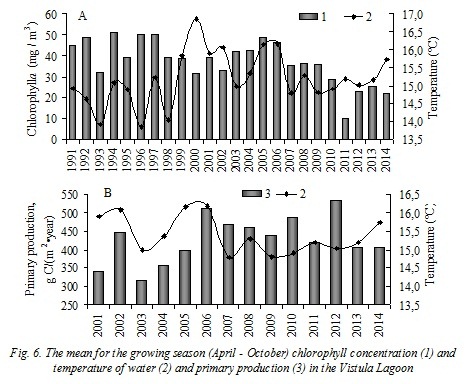
The climate change in 1990s-2010s also affected the water temperature in the Vistula Lagoon. During the latest decades the trend towards increase number of “warm” years has been observed. The mean for the growing season water temperature above 15.0°С was observed only once in 1970s, 4 times in 1980s and 1990s, and 12 times in 2000s (Fig. 4). Mean annual temperature water increased by 1.2°С for 40 years (from 14.2 °С in 1970s to 15.4 °С in 2000-2010s), and warming and the increase in the number of “warm” years combined with other factors created conditions for phytoplankton “blooms” in 1995-2014. In “warm” years the tendency of a growth abundance and biomass phytoplankton and increase in the share of Cyanobacteria in total biomass. In “cold” years the phytoplankton abundance decreases and the share of Bacillariophyta and Chlorophyta in the total biomass increases [16].
The trend to increase the primary production of phytoplankton was recorded in the Vistula Lagoon in 2000s and 2010s (Fig. 5). Mean annual primary production in 2000s and 2010s (415 and 450 gC/(m2∙year)) is considerable higher, than in the middle of 1970s (300 gC/(m2∙year)).
Great changes have taken place in the Vistula Lagoon in the 2010s after the invasion of the North American brackish water filter-feeding bivalve Rangia cuneata [17]. The benthic biomass increased by 20 times (from 29 g/m2 in 2000s to 650 g/m2 in 2012) and Chl a decreased by 2 times (from 40 g/m3 in 2000s to 20 g/m3 in 2010s). Before the invasion the regular algae "hyperbloomings" were observed in the lagoon. In 2011 and 2012, the summer algae bloom was not observed and the Chl a was at minimal level (Fig. 6). In the last 2 years the seasonal dynamics of phytoplankton recovered, but the abundance of phytoplankton and Chl а have stabilized at a lower level compared with the previous decade. Invasion mollusk has impact on the primary production. The phytoplankton assimilation numbers as an indicator of the rate of photosynthesis increased by 2-3 times (to 300-400 mgC/(mgChl·day). Transparency also increased by 2 times and now the photic zone reaches the bottom. As a result, primary production under m2 in 2011 remained at long-term level, despite Chl decreased by 4 times. In 2012, primary production increased due to the spring bloom, and it reached a maximum.
So, invasion filter-feeding mollusks significantly improved water quality but primary production in the ecosystem of the Vistula Lagoon remained on long-term eutrophic-hypertrophic level, which creates favorable conditions for the other trophic groups (zooplankton, benthos, fish). If global warming continues, can be expect to remain long-term trend of increasing primary production and eutrophication in the Vistula Lagoon. In the Vistula Lagoon intensive filter-feeding mollusks and "critical salinity" will prevent harmful algal blooms and promote the conservation water quality at possible levels.
IV. Conclusions
Curonian and Vistula Lagoons are the largest coastal lagoons of the Baltic Sea, relating to the most highly productive water bodies of Europe. Reductions of nutrients loading in 1990s did not result in improvement of the ecological situation. In these Lagoons, unlike many inland and coastal marine waters, eutrophication of water continues. Hydrological and chemical parameters are the main factors that influence on the algal blooms and ecosystem health in these lagoons. The Curonian Lagoon may be characterized as a hypertrophic water body. In recent decades "hyperblooms" of Cyanobacteria are observed more frequently in the Curonian Lagoon. The Vistula Lagoon may be characterized as eutrophic or hypertrophic for different parts. The more intensive water warming and the increase in the number of “warm” years in 1990s-2000s created favorable conditions for algae blooming and high rates of primary production in the lagoons. The local climate warming in the Baltic region is a probable reason of the ongoing eutrophication of the Curonian and Vistula Lagoon despite of significant reduction of external nutrients loading in 1990-2000s. If global warming continues, can be expect to remain long-term trend of increasing primary production and eutrophication in the Curonian Lagoon and the Vistula Lagoon. In the Curonian Lagoon climate changes represents a risk for ecosystem, as this stimulates hyperblooms of Cyanobacteria. Harmful algal blooms result in deterioration of the water chemical parameters and death of fish in the Curonian Lagoon. "Hyperblooms" is the most dangerous for coastal towns and tourist resorts (UNESCO National Park "Curonian Spit"). In the Vistula Lagoon intensive development of filter-feeding mollusks will prevent harmful algal blooms and promote the conservation ecological state at possible levels.
1. “Environment of the Baltic Sea Area 1994-1998”, Baltic Sea Environment Proceedings, vol. 82. HELCOM, 2002.
2. “Climate Change in the Baltic Sea Area”, Baltic Sea Environment Proceedings, vol. 111. HELCOM, 2007.
3. “Chemical measurements in the Baltic Sea: Guidelines on Quality assurance”, ICES techniques in marine environmental sciences, vol. 35. Copenhagen, 2004.
4. L. Edler, “Recommendations on methods for marine biological studies in the Baltic Sea. Phytoplankton and chlorophyll”, Baltic Marine Biologist, vol. 38, 1979.
5. R.A. Vollenweider, J. F. Talling, D.F. Westlake, A manual on methods for measuring primary production in aquatic environments. Backwell Scientific Publications, 1974.
6. L. Hakanson, V.V. Boulion, The like foodweb- modeling predation and abiotic/biotic interactions. Leiden: Backhuys Published, 2002.
7. N. Wasmund et al., “Trophic status of the south-eastern Baltic sea: a comparison of coastal and open areas”, Estuarine, Coastal and Shelf Science, vol. 53, pp. 849-864, 2001.
8. I. Olenina, “Long-term changes in the Kursiu Marios lagoon: Eutrophication and phytoplankton response”, Ecologija, vol. 1, pp. 56-65, 1998.
9. S.V. Aleksandrov and O.A.Dmitrieva, “Primary Production and Phytoplankton Characteristics as Eutrophication Criteria of Kursiu Marios Lagoon, the Baltic Sea”, Water Resources, vol. 33 (1), pp. 97-103, 2006.
10. A. Cetkauskaite, D. Zarkov, L. Stoskus, “Water-quality control, monitoring and wastewater treatment in Lithuania 1950 to 1999”, Ambio, vol. 30 (4-5), pp. 297-305, 2000.
11. G.J. Waughman, “The effect of temperature on nitrogenase activity”, Journal of Experimental Botany, vol. 28 (105), pp. 949-960, 1977.
12. B.A. Whitton, “Freshwater plankton”, The biology of blue-green algae, vol. 9, pp. 353-367, 1973.
13. O.I. Belykh et al., “Identification of toxigenic Cyanophyta of the genus Microcystis in the Curonian Lagoon (Baltic Sea)”, Oceanology, vol. 53 (1), pp. 71-79, 2013.
14. A. Paldaviciene, H. Mazur-Marzec, A. Razinkovas, “Toxic cyanobacteria blooms in the Lithuanian part of the Curonian Lagoon”, Oceanologia, vol. 51 (2), pp. 203-216, 2009.
15. N. Chukalova and O. Dmitrieva, “Main results of fish disease monitoring in the Curonian Lagoon (the South East Baltic Sea)”, Health and Diseases of Aquatic Organisms: Bilateral Perspectives. International Standard Book. Living Ocean Foundation. Michigan State University, 2010. pp. 24-31.
16. S.N. Semenova and V.A. Smyslov, “Peculiarities of the State of Phytoplankton in the Baltic Sea's Vistula Lagoon at the Turn of 21st Century”, Inland Water Biology, vol. 2 (4), pp. 305-311, 2009.
17. S. Aleksandrov, J.Gorbunova, L. Rudinskaya, “Effect of climate change and mollusc invasion on eutrophication and algae blooms in the lagoon ecosystems of the Baltic Sea”, Geophysical Research Abstracts, vol. 17. EGU General Assembly, 2015. EGU 2015-5846.







